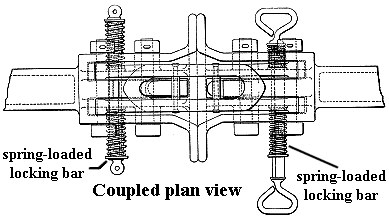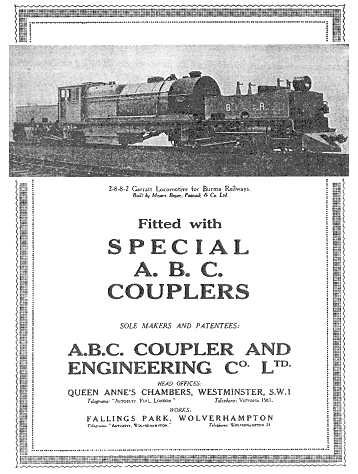| Most of Wolverhampton’s great industries have now
disappeared and very little remains to remind us of our
wonderful industrial heritage. Many manufacturers are fondly
remembered by their ex-employees and often their names crop up
in conversation. One if these is the A.B.C. Coupler and
Engineering Company Limited who had a sizeable factory in
Park Lane, Fallings Park.
The Automatic Buffing Contact Coupler and Engineering Company
(a public limited company) was formed on 3rd March 1904 as an agency that
sub-contracted work to outside manufacturers and developed
products that were made by outside companies under licence.
ABC’s head office was at Queen Anne’s Chambers, Tothill Street,
Westminster.
One of the first products was the automatic coupler that was
invented and patented by J. T. Jepson. The patent application,
number 25,511 is dated December 1905 and this was accepted on 16th
August, 1906. |

J. T. Jepson's original design for an
automatic coupler. The Railway Engineer, November 1906. |
The invention consists of a pair of automatic couplers that
are locked together by a shackle and a hook.
There are two shackles that overlap when in the coupled
position. The lower one is engaged over the hook of the opposite
coupler and the upper shackle overlies the lower and secures it
in its coupled position.
Uncoupling is achieved by raising the upper shackle into its
inoperative position through a recess in the buffer. |
| When the upper shackle is raised, a tail lever on
its lower surface lifts the lower shackle clear of the hook and
the coupling is disengaged.
The automatic couplers were ideal for use on narrow gauge
light railways and large numbers were sold to the British
Colonies. By 1911 the ABC coupler had been adopted as the
standard type on the 2ft.6inch gauge Bauchi Light Railway in
Northern Nigeria and 4 locomotives and 55 vehicles using the
couplers were constructed by order of the Crown Agents for the
Colonies. At the same time the couplers were in use in Ceylon,
Honduras and on the Kalka-Simla State Railway in India, which
has gradients of 1 in 33 and curves of 120ft. radius. |

One of the wagons built by the Leeds Forge
Co. for the Kalka-Simla Railway showing the ABC coupler. These
were identical to the standard type except that chains were used
instead of locking bars. The Railway Engineer, July 1911. |

| The improved
coupler with rotating disc hooks. The Railway Engineer,
March 1912. |
|
By 1912 the coupler had been greatly improved and
continued to sell well, especially to railways that used centre
link and pin couplings. The design was robust and simple with
few moving parts.
It could automatically couple vehicles on straight or curved
track and cope with height differences of 4 inches on standard
gauge stock and from 2.5 to 3 inches on narrow gauge stock. |
| The smaller size had a breaking strain of 50
tons, which increased from 65 to 70 tons with the standard size.
The new design used disc hooks that were designed to open
automatically during uncoupling. When vehicles are coupled the
shackle rotates the disc hook into the locking position and is
held by a spring-loaded locking bar. Uncoupling is simply
achieved by pulling a chain or handle to disengage the locking
bar. |

| A plan view of the
new coupler. The Railway Engineer, March 1912. |
|
|

The new coupler. The Railway Engineer,
March 1912.
|

ABC's works in the late 1920s or early
1930s with Guy Motors in the background. Courtesy of Ken Foster. |
The company opened its Park Lane factory in 1915
and by 1951 the site covered approximately four acres.
By 1919 a non-automatic coupling had been added to the
product list, patent number 123,636. It consisted of a sliding
link that engaged with a coupling link. |
| All types of railway coupling devices were
manufactured at Park Lane including the standard British hook
and shackle with a three-link chain, the “Instanter” link, an
automatic mine car coupler designed for tipping cars, and
various screw and shackle designs, although the company was best
known for the ABC automatic couplers. Other railway products
manufactured under the ABC name included the “Lockyer” balanced
regulator valve, buffers, by-pass valves, drawgears, main
pistons for locomotives, and brake slack adjusters. |

An advert from 1916. |
|
Other railway components were manufactured
at Park Lane under the “WOTA” (Wonder Of The Age) name. Wota
Limited was a wholly owned subsidiary company that produced a
large range of products including axle boxes, bearings, by-pass
valves and regulators, some of which were manufactured under
licence.
In 1939 the registered office moved from
London to Wolverhampton. Sales were high and the company had an
extensive export trade supplying railways in India, Pakistan,
Australia, Nigeria, Kenya and Uganda. During World War 2 this
suffered because of trade restrictions, but once the war was
over things soon recovered because of the vast amount of railway
reconstruction work that took place at the time.
|

An advert from The Locomotive magazine,
15th December, 1927. |
 |
|
 |
Return to
F. H. Lloyd |
|
Proceed to
the
next page |
|